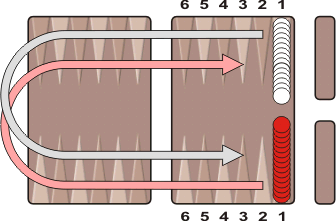![[Backgammon Galore!]](/gif/GaloreButton.gif)
|
|
Backgammon Variants Setup: Each player starts with fifteen checkers on the opponent's one-point.
Object: The object of the game is to move all of your checkers around the board to your own home table and then bear them off. The first player to bear off all of his checkers wins the game. Start: Both players roll one die and the higher number goes first. That player rolls both dice again to begin his first turn. After the first game, the winner of the previous game goes first. Movement: The roll of the dice indicates how many points, or pips, the player is to move his checkers. The following rules apply:
Hitting and trapping: A checker sitting alone on a point is called a blot. When one of your checkers lands on an opposing blot, you have a choice of either trapping the blot or hitting it. To "trap" an opposing blot, you move your checker onto the same point occupied by the blot. The trapped checker may not leave that point as long as your checker remains. You now own the point and your opponent may not use the point either to land on or touch down. To "hit" an opposing blot, you move your checker to the point occupied by the blot and the place the blot on the bar. Reentering hit checkers: Any time a player has one or more checkers on the bar, his first obligation is to reenter those checker(s) into the opposing home board. You enter a checker by moving it to an open point corresponding to one of the numbers on the rolled dice. If you are able to enter some but not all of your checkers, you must enter as many as you can and then give up the remainder of your turn. Bearing Off: Once you have moved all fifteen of your checkers into your home board, you may begin bearing off. You bear off a checker by rolling a number that corresponds to the point on which the checker resides, then remove it from the board. If there is no checker on the point indicated by the roll, then you must make a legal move using a checker on a higher-numbered point. If there are no checkers on higher-numbered points, you must remove one of your checkers from the highest point that has a checker. Scoring: The first player to bear off all of his checkers wins the game and scores one point. If the winner bears off all his checkers before the loser has borne off any, he gets two points. No doubling cube is used in this game.
References
|
![]()
Backgammon Galore : Variants

